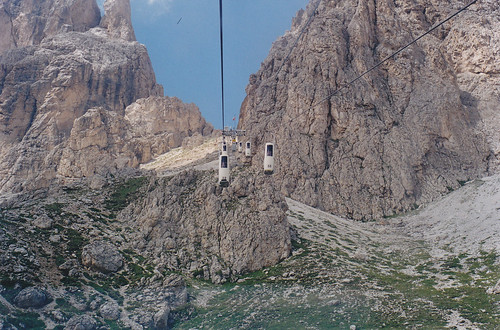This is a guest post by Ross Edgar.
The Sassolungo, also known as the Langkofel, is one of the most distinctive peaks in the Italian Dolomites and arguably, the world. This stunning rock massif towers over the South Tyrol region of northern Italy and is widely photographed thanks to its iconic profile. It is fitting, therefore, that such a unique and distinctive mountain should be home to an equally unique and distinctive cable system.
The Telecabina Sassolungo, originally constructed in 1972, is often referred to as a ‘coffin lift’ due to the shape of its tall but narrow cabins. The Telecabina climbs a vertical ascent of 493m, or 1,600ft, over a horizontal distance of 1522m, or approximately 1 mile. Although this gondola system does not feature cutting-edge technology, it does aptly demonstrate that gondola technology and CPT technology in general is not new and unproven, but rather that it has been extensively tried and tested. Testimony to this fact is that such an old and antiquated system is operating safely and efficiently over forty years after its construction. Equally, with all of the infrastructure and paraphernalia associated with modern gondolas, it is important to remember how simple the basic concept really is.
Similar to the older generation of gondola found at the Heights of Abraham in England, the Telecabina’s winding gear appears to be able to move backward and forward within the station, again presumably to maintain cable tension. Another similarity is the lack of storage space for cabins, the lack of independent station cable systems and it is assumed that the cabins are fixed rather than detachable.
Therefore, unlike modern gondolas, the Telecabina Sassolungo features only a single cable propulsion system, meaning that the cabins do not move at a slower speed within the valley and summit stations. Moreover, access to the cabins is gained via a manually operated door to the rear. As a result, passengers find themselves in the rather bizarre situation of having to chase after the cabin in order to board. The manual doors are opened, closed and locked by a gondola operative, who follows closely behind the boarding passengers.
Exiting the Telecabina is equally challenging. Due to the unconventional positioning of the exit to the rear of the cabin and the relatively high speed of 2m/s within the stations, there is a tendency to stumble backward on exiting the cabin. To counter this there is often a gondola operative on hand to catch unsuspecting passengers and assist them in regaining their balance. Due to the size and shape of the cabins there is only room for two people in the standing position in each cabin.
The Telecabina Sassolungo is a fascinating insight into gondola technology of yesteryear. The somewhat comical means of boarding and alighting perhaps goes some way to illustrate why many have struggled in the past to take gondolas seriously as a credible means of urban transit. While a ‘coffin lift’ would be entirely impractical for mass transit purposes, modern gondolas feature much greater cabin space and therefore considerably increased capacity, not to mention significantly more refined boarding techniques. However, without pioneering gondola systems such as the Telecabina Sassolungo and those of later generations, gondola technology would not be what it is today.



1 Comment
See another Dolomite gondola, Seceda Cable Car featured here: http://blog.wikimedia.org/2013/07/09/wikimedia-commons-picture-of-the-day-seceda-cable-car/